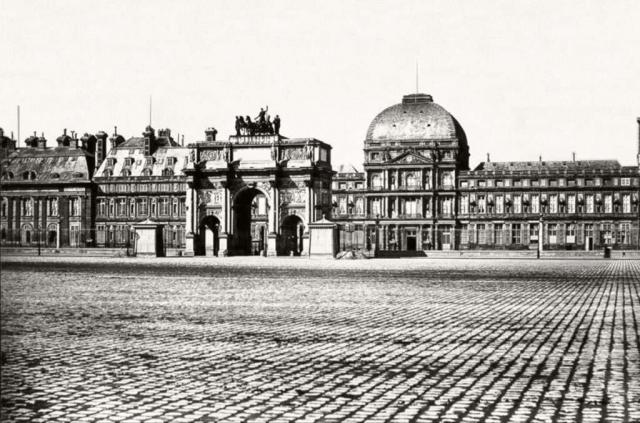Paris boasts a fascinating history filled with palaces, châteaux, fortresses, and castles, some of which no longer exist. The Tuileries Palace, once gracing the heart of Paris, was tragically burned down during the Commune of 1871. Its grandeur is now remembered through historical accounts and artistic depictions.
The Château de Meudon transformed facing destruction, evolving into an observatory that remains a part of French scientific heritage. The Palais de la Cité, though modified over time, preserves medieval elements in the form of the Sainte-Chapelle and the Conciergerie, allowing visitors a glimpse into the city’s historical roots.
While many palaces no longer exist, their impact echoes through French history, with figures like Catherine de’ Medici leaving their marks on these once-grand residences. The missing palaces serve as reminders of the city’s dynamic past, ensuring they remain an integral part of its collective memory.
1. Tuileries Palace
The Tuileries Palace was built by Catherine de’ Medici in the 16th century, starting in 1564. Catherine became the queen consort of France through her marriage to King Henry II.
Initially, the Tuileries Palace was meant to be a place of retreat and escape from the Louvre Palace, which was the main royal residence.
Located in the 1st arrondissement of Paris, between the Louvre Museum and the Place de la Concorde. It occupied a central location in the city, adjacent to the right bank of the Seine River.
The palace featured a Renaissance design, but subsequent modifications incorporated Baroque elements. Unfortunately, it was destroyed during the Paris Commune in 1871, leaving behind the Tuileries Garden as a reminder of its historical significance.
2. Palais de la Cité
The Palais de la Cité, located in the Île de la Cité, was a medieval royal palace and the residence of French kings from the 6th to the 14th century.
Originally built for defensive purposes, it evolved into a symbol of royal power. Today, the only surviving medieval parts are the Sainte-Chapelle, a stunning Gothic chapel, and the Conciergerie, which later served as a prison during the French Revolution, over 2,700 prisoners were imprisoned here, including Marie Antoinette.
Today, these two buildings do not belong to the same complex anymore but can be visited through different entrances.
The rest of the palace was extensively modified and expanded over the centuries, transforming into the modern Palais de Justice.
3. Trocadéro Palace
The Trocadéro Palace in Paris was built for the 1878 Exposition Universelle (World’s Fair of 1878). Designed by Gabriel Davioud and Jules Bourdais, its style was inspired by various influences, including Moorish and neo-Byzantine elements.
Located on the hill of Chaillot, it provided a panoramic view of the city and the Eiffel Tower. The palace served as a cultural and entertainment center, housing museums, theaters, and galleries.
The building was never meant to last longer than the fair, even so, remained in place for sixty years.
However, due to structural issues and the desire for modernization, the Trocadéro Palace was demolished in 1937. The site was then redeveloped, and the Palais de Chaillot, a complex featuring two separate wings, was constructed in its place for the 1937 Exposition Universelle.
The new Palais de Chaillot retained the original location’s cultural and exhibition functions, and it still stands today as a prominent landmark in Paris.
4. Château de Saint-Cloud
The Château de Saint-Cloud was a grand palace built in the 17th century, situated in the western suburbs of Paris. Construction began in 1572, and it served various purposes over the years, functioning as a residence for French royalty, including Louis XIV and Napoleon Bonaparte.
The château was renowned for its beautiful gardens and played a significant role in French history as a site for royal gatherings and political events. Unfortunately, during the Franco-Prussian War in 1870, the Château de Saint-Cloud was severely damaged by Prussian artillery fire. Subsequently, in 1871, a fire broke out, leading to further destruction.
Efforts to restore the château proved challenging, and eventually, the decision was made not to rebuild it. The ruins were partially demolished in the 19th century, leaving only remnants of the once magnificent structure. The park surrounding the former château, known as the Parc de Saint-Cloud, remains a popular public space.
5. Château de Meudon
The Château de Meudon, located between Paris and Versailles, has origins dating back to the 15th century. During the Renaissance it was home to the Sanguin family, the castle was then sold to the Cardinal of Lorraine in 1552, who renovated the place.
Later the castle received another renovation, this time by its new resident: the Grand Dauphin.
Tragically, the château experienced two devastating fires. The first occurred in 1795, destroying much of the structure. Despite efforts to rebuild, another fire in 1871 led to the destruction of the reconstructed Château-Neuf.
In the face of possible demolition, a decision was made to preserve the remaining parts of the castle. In 1878, an astronomical telescope was installed, and the site became an observatory. This observatory, with its telescope, was later integrated into the Paris Observatory in 1927. The Château de Meudon, now serving a scientific purpose, stands as a historic and astronomical landmark in the region.
Conclusion
Paris indeed had a rich history of palaces, châteaux, fortresses, and castles, many of which are no longer standing today. Influential figures like Catherine de’ Medici left their mark on these structures, which are long gone.
Over time, factors such as fires, political changes, and evolving architectural trends contributed to the disappearance or transformation of these landmarks. The fate of these historical sites often reflects the dynamic and complex history of Paris and its role as a center of political, cultural, and social activity.
The post 5 Palaces that no longer exist in Paris appeared first on World by Isa.
This post first appeared on WORLD BY ISA | Travel, Culture & History, please read the originial post: here

